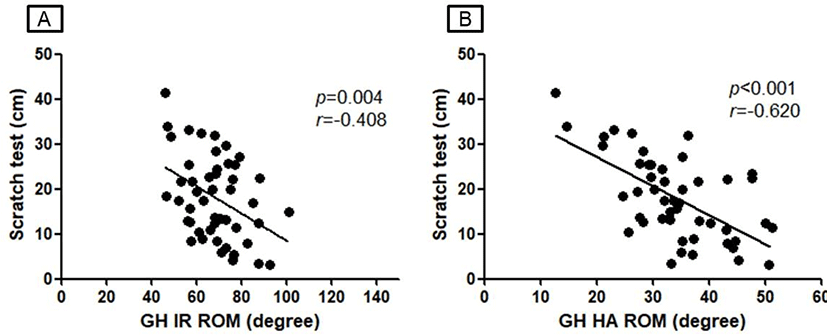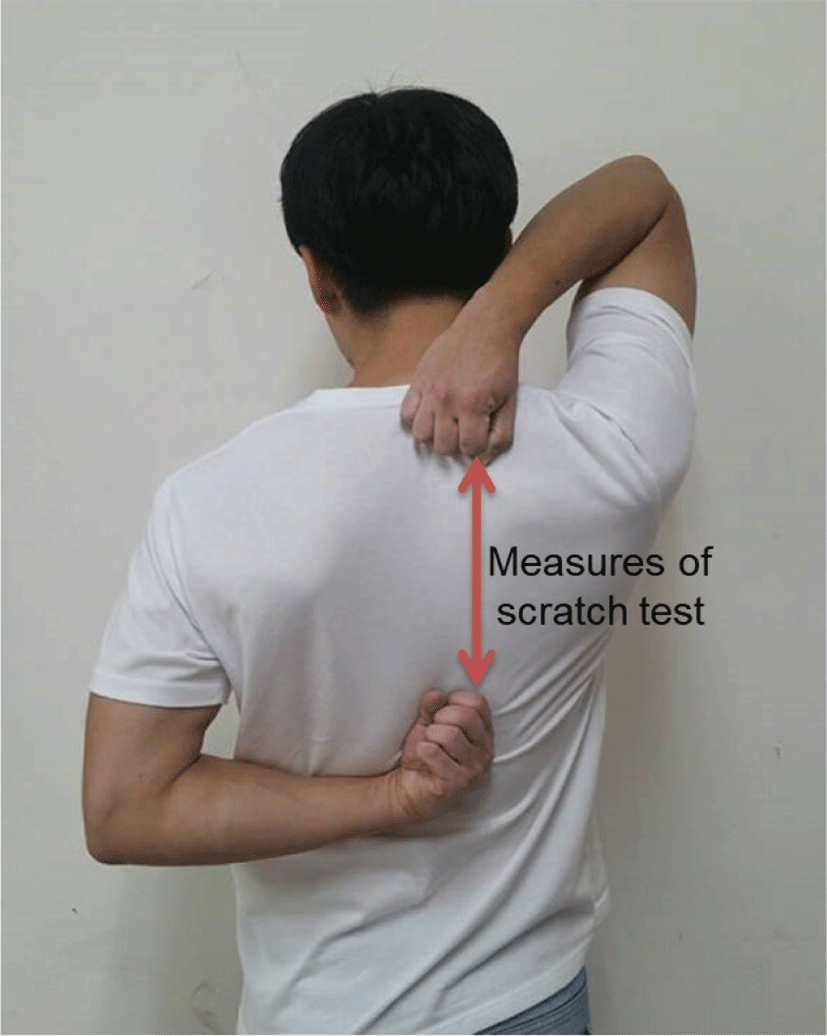INTRODUCTION
Limitation of shoulder range of motion (ROM) is associated with various shoulder injuries.1-3 Limited shoulder ROM is caused by tightness of muscles surrounding shoulder joint and glenohumeral (GH) joint capsule tightness.3-5 Especially, it has been reported limited GH internal rotation (IR) ROM due to tightness of posterior shoulder tissues leads to shoulder impingement and shoulder labrum lesion.1-3 In addition, tightness of posterior shoulder tissues induce anterior translation of humeral head during GH horizontal adduction (HA), that leads to abnormal arthrokinematics of GH joint.6 So, GH IR and HA passive ROM (PROM) is often measured to identify causes of shoulder injuries in clinical settings.
Measures of GH IR PROM are generally performed in supine position with fixation of scapula for accurate measures.4,7-9 Similarly, GH HA PROM is measured while fixing scapular lateral boarder to limit unnecessary scapular movement.10,11 These methods facilitate measurement of shoulder ROM accurately; however, these methods could lead to difference in measured value depending on expertise of examiners. The scratch test is another way to measure combinedshoulder IR ROM.12 During the scratch test, both hands are placed on upper and lower regions of the back, respectively, so combined shoulder IR, adduction, and extension in the lower arm side are measured.12 This maneuver has the advantage of facilitating quick and easy understanding of limitation of shoulder movement.
To address posterior shoulder tightness, various stretching exercises (e.g., sleeper stretching and cross-body stretching) are performed in clinical settings. Previous studies revealed that GH IR and HA ROM significantly increased after these stretching exercises.5,9,10,13 These findings support that GH IR and HA PROM are valid variables to identify posterior shoulder tightness. However, traditional methods of GH IR and HA PROM measures have time constraints. Although the scratch test could identify combined GH IR ROM quickly, no study examined the relationship value of scratch test and GH IR and HA ROM. Only significant correlation between GH IR and HA PROM was identified in previous studies.3,14,15 So, the purpose of this study was to identify the relationship between the scratch test and GH IR and HA ROM.
METHODS
In total, 24 university students without shoulder pain (10 males and 14 females; age = 23.00±2.23; height = 167.67±7.71 cm; body weight = 64.33±10.65 kg) were recruited in this study. Participants were excluded if they had history of shoulder surgery or shoulder injury in the last year. Participants provided an explanation of procedures and agreed to participate.
GH IR ROM was passively measured in supine position with 90° of flexion of shoulder and elbow in the tested side. An examiner passively lowered forearm for GH IR while grapping coracoid process to identify movement of scapular tilt.7,9 When an examiner felt scapular movement, passive IR was stopped, and smartphone was placed on the dorsal side of the forearm. The end-range of GH IR angle was measured using the smartphone application of inclinometer (Clinometer-level and slope finder; Plaincode Software Solutions, Stephanskirchen, Germany).
To measure GH HA PROM, participants were positioned in supine position with 90° of flexion of shoulder and elbow in the tested side. An examiner gapped and fixed lateral boarder of scapular using thenar eminence to limit unnecessary scapular protraction while moving humerus across the body without humeral rotation.10,11 Smartphone was placed onthe dorsal side of the humerus at the end-range of GH HA, and the HA angle was measured using smartphone application of inclinometer.
To perform the scratch test, participants were asked to place a hand, in the tested side, on the lower region of the back while the other hand was placed on the upper region of the back (Figure 1).12 During the scratch test, participants were instructed to clench fists. The distance between two fists was measured using a tape measure.
The measures of variables were performed in a random order. Bilateral measures at each variable were repeated three times and mean value of three measurements was used for data analysis. Mean and standard deviation of each variable was calculated using descriptive statistics. Pearson product moment correlations were performed to identify the relationship between the scratch test and GH IR and HA PROM. Magnitude of the relationship was classified as slight (r<0.25), fair (0.25≤r<0.50), moderate to good (0.50≤r<0.75), and good to excellent (r≥0.75). The PASW Statistics 18 (SPSS Inc, Chicago, Illinois) was used as statistical analysis with a level of p<0.05.
RESULTS
The mean±standard deviations of GH IR, GH HA, and the scratch test were 68.33±12.49°, 34.10±8.87°, and 18.14±9.28 cm, respectively. Value of the scratch test significantly correlated with GH IR PROM (p=0.004, r=−0.408; Figure 2A) and GH HA PROM (p<0.001, r=−0.620; Figure 2B).

DISCUSSION
Present findings demonstrate that the scratch test has greater relationship with GH HA PROM than GH IR PROM.
A fair correlation between the scratch test and GH IR ROM was affirmed in this study (r=−0.408). In this study, GH IR PROM was measured in the position with 90° of shoulder abduction. This shoulder position increases tension of posterior-inferior portion of GH joint capsule.16,17 However, the scratch test was performed from 0° of shoulder abduction to position of shoulder adduction, that may rather loosen the inferior GH joint capsule and increase superior GH joint capsule. So, the difference in shoulder position between two tests may influence relatively weak correlation between two variables. Previous findings by McClure et al.,13 that examine the relationship between value of thumb up the back (TUB) test, the distance between first thoracic spinous process and thumb in the lower back, and GH IR PROM, support our results. Previous findings revealed a fair correlation between TUB test and GH IR PROM (r=−0.44),13 similar with our findings (r=−0.408). Based on previous and present findings, the scratch test may help fairly predict GH IR PROM.
Present findings revealed moderate to good correlation between the scratch test and GH HA ROM (r=−0.620). Previous cadaveric study compared change in tension of GH joint capsule between natural condition and contracted joint capsule condition.18 The previous study revealed decrease in joint capsule tension by 4% in the lower region and increase in joint capsule tension by only 4% in the middle region during GH HA when the contraction condition was compared to the baseline condition.18 Considering that GH IR ROM has significant relationship with posterior capsule tightness3 and GH HA ROM,14,15 posterior capsule tightness may be also correlated with GH HA ROM. However, contraction of posterior GH joint capsule has minimal effect on tension of middle and lower GH jointcapsule during GH HA movements.18 So, it is reasonable that GH HA movements may increase tension of superior region of GH joint capsule. Based on previous findings, tension of superior GH joint capsule is influenced by position of the scratch test and GH HA movements, that may result in moderate to good relationship between the scratch test and GH HA PROM in this study.
There are limitations in this study. First, the value of scratch test is affected by shoulder IR ROM as well as contralateral shoulder external rotation ROM. Considering that our findings are similar with a previous finding that revealed correlation between GH IR ROM and value of TUB test,13 however, the scratch test may reflect limitation of GH IR ROM. Second, only young subjects were recruited in this study. Future studies must include subjects of various ages and subjects with shoulder pain.
CONCLUSION
This study demonstrates significant correlation between the scratch test and GH IR and HA PROM. Also, the scratch test has moderate to good correlation with GH HA PROM while it has fair correlation with GH IR PROM. These findings suggest that the scratch test could be helpful as well as quick measurement to identify GH joint ROM.








